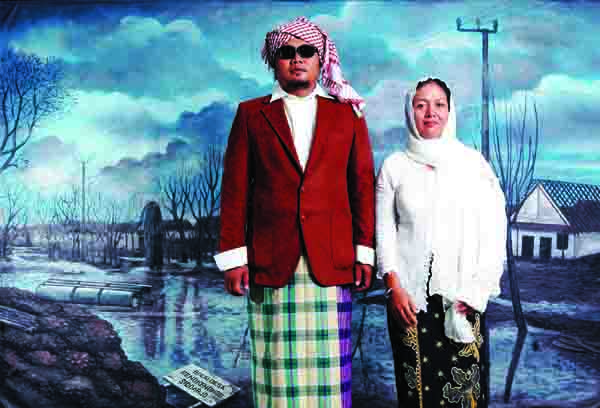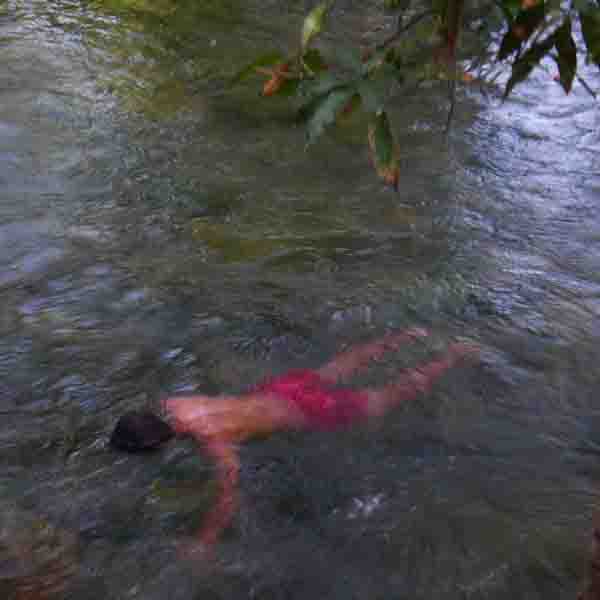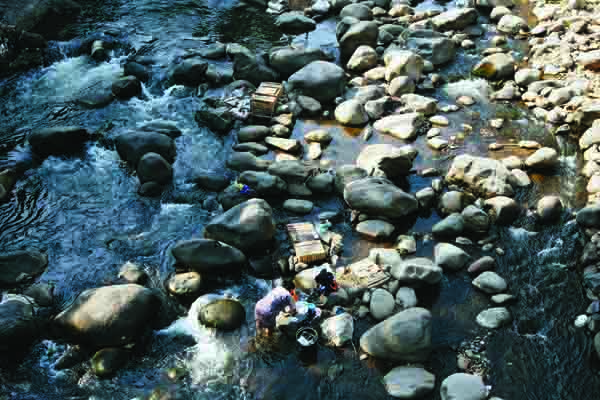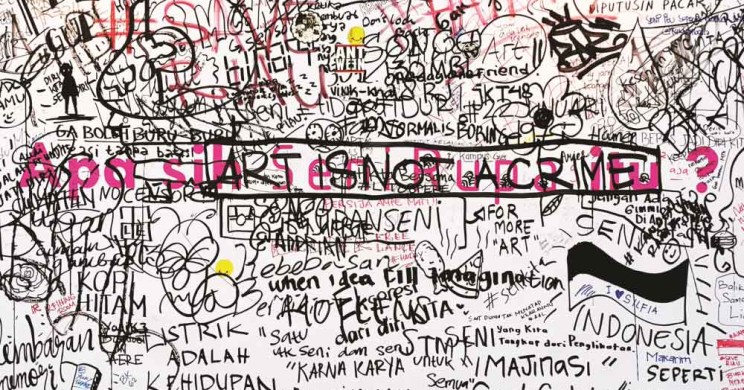Neither Forward nor Back
Charles Esche
The 2015 edition of the Jakarta Biennale is called ‘Neither Forward nor Back’. This title comes from an Indonesian comedy film of the 1980s but refers to a local expression for a typical Indonesian situation. We have interpreted this situation to mean that we must focus on the moment and on the contemporary situation around us. We refuse to look back with nostalgia at a past that is out of reach, or forward to an unachievable utopia. Instead the exhibition focuses on the here and now and the responses of artists to the social, political and economic conditions in which they find themselves. Urban history and memory are very relevant to the exhibition but only as issues of current concern in the sense of how they impact the possibilities of thinking and doing today. The environment features strongly too, particularly through the use and abuse of water. Finally, social and sexual difference, particularly in regard to the role of women and queerness, forms the third principle stream of influence on this Biennale.

Produk-Gertoli Yogya, 2008
These issues: the city and history; water and the environment; and the right to behave differently became the leitmotifs for the biennale. They are ideas that link works together and run throughout the exhibition. each one of these issues is grounded in what the curators perceive as vivid and on-going concerns here in Indonesia. as a team, we have also used our collective knowledge and experience to invite artists from other cities and continents who appear to be relevant to the situation here. These artists have sometimes made new work in Indonesia but they also bring reports and insights from elsewhere that can offer useful perspectives on what is happening here.
Small Victories – an account of making the 2015 Jakarta Biennale
“You mean like small victories,” Irma said to no one in particular. The seven curators of the 2015 Jakarta Biennale were discussing the basic ideas that should inform their project.
“Yes,” I said. “Kind of like small victories, I suppose. I guess that’s why we keep doing things, why artists develop their projects, why people go to see them… we keep hoping for small victories.”
The project began in January 2015 with a first meeting together and the beginnings of my own travels around Jakarta and Indonesia. Visiting NGOs and other active groups in the city, I was struck by the way the issue of water regularly returned in our conversations. along with religion, 1965 and the current government; water was a less pre-defined topic that seemed to resonate with everyone. In the first meetings with the curatorial group, I brought up the question of water and the conversation turned to flooding and pollution, ranging over the state of the Ciliwung river to the communities that lived—legally and illegally—on its banks and the dangers from a lack of clean water. This experience of water was repeated with lifepatch in Yogyakarta; the strenkali community in surabaya and the Kampung Pisang in Makassar. later, we looked at the sanggar anak akar, a place of street children living by the Ciliwung river and at Peta Jakarta, an important social media initiative to avoid flooding. all these experiences confirmed the centrality of clean water to a good life, but also how the abuse of water could stand as a perfect example of the despoliation of the environment in general and how ignoring human dependency on the earth seriously reduces our chances of survival. The environment became then a key motif, understood as a subject that exists alongside all the humans in the world, a subject that needs care and sustenance as much as any individual.

Karolus Naga berenang di Pemandian Air Panas Mengeruda di Kecamatan Soa, Bajawa. Foto: Ng Swan Ti
The influence of water flows throughout this biennale, but it is not alone as a key subject. The related concern for the city of Jakarta and its histories, especially how much urban communities are able to define ways of living together themselves, is a reference for many of the artworks. New murals by six Indonesian women artists commissioned for a number of locations throughout the city are grounded in their responses to particular issues within the urban fabric, such as space for children, the influence of migration or the significance of local cultural heritage amidst rapid development. These topics are also taken up in the main exhibition with the city’s role as a public theatre returning constantly in various works. Other artists tackle the contemporary relationship with history and remembering, especially as those memories counter the mainstream narratives told by governments and corporations. The need for spaces of ritual in civic society both by using monuments and claiming space for demonstrations and public performance is also a red thread through the exhibition. Finally, the architectural design of Gudang Sarinah draws directly on the experience of the city with its closed and intimate kampong-like zones contrasting with the more formal open courtyard in the centre.
A third stream of ideas came into the biennale through the traditions of feminism, gender studies and inter-cultural dialogues. Finding room and legitimacy to deviate from a socially approved set of behaviours is crucial for most individuals. Few of us conform precisely to what our society expects, yet the pressures to comply are sometimes overwhelming. artists can often be pathfinders in squeezing out possibilities in unlikely situations, and many works in the biennale present other options to the social path most often taken. This condition of deviance or queerness implicates a majority of groups in society who seek to be active agents in their societies, individuals who make other sexual choices, communities that have other beliefs from the surrounding majority. It is one of the crucial tasks of an open society to allow these differences to flourish, and art is one of the fundamental ways in which they can be expressed. In the biennale, you will encounter works that question common norms and values in order to create room for other ways of thinking about society, gender, sex and living together.
We decided as we were constructing the exhibition not to divide it into three sections but to run each one of the three issues in and around the others. This was because we saw so many relationships between the themes and chose many works and artists that touched on two or three of them at the same time. Instead we planned the exhibition based on what the works themselves needed in terms of space and levels of attention from the visitors. We also removed the usual division in previous Jakarta biennales between emerging and established artists. We felt it better to mix everything together in a continuous experience spread throughout a single exhibition venue.

Evelyn Pritt, Cleanliness Photography, installation Various dimensions, 2015
‘Neither Forward nor Back’ was an obvious title. The exhibition wants to exist firmly in the present, where the issues and the small victories in the world today can be stacked up one beside the other to point out ways out of what can often seem like a contemporary gloom and impossibility to act with conscience and meaning for today.
In this publication, you will be able to learn more about the individual artists and groups and to make your own lines of connection between them. I would like to thank all my colleague curators greatly for their generosity; rich, inspiring conversations; and all the exchange of thoughts about art, Indonesian society, the value of history and tradition and the world today that went into producing this project. I hope we have made a Biennale to be proud of, one that has been generated for Jakarta and that will spread out its influence across the city, Indonesia and beyond over the next months and years.
























